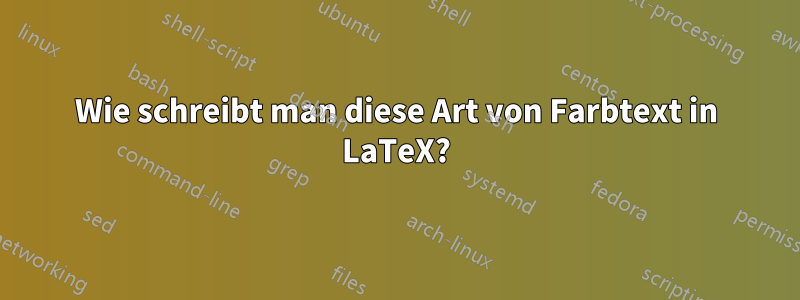
Ich muss meinem Latex-Dokument folgenden Text hinzufügen. Derzeit habe ich ein Bild erstellt und es dem Dokument hinzugefügt.
Ich muss wissen, wie ich es auf einfache Weise als Text zu meinem neuesten Projekt hinzufügen kann.
Außerdem muss es auf der Seite zentriert werden und es muss eine Schriftgröße verwendet werden, die größer als die Standardschrift ist. (Der Standardtext meines Dokuments ist 12 pt.) Es muss kein Rahmen hinzugefügt werden.
Antwort1
So was?
\documentclass{article}
\usepackage{xcolor}
\begin{document}
\begin{center}
\Large\sl
\textcolor{red}{S}ince \textcolor{red}{E}veryone \textcolor{red}{C}an \textcolor{red}{R}ead, \textcolor{red}{E}ncoding \textcolor{red}{T}ext \textcolor{red}{I}n \textcolor{red}{N}eutral \textcolor{red}{S}entences \textcolor{red}{I}s \textcolor{red}{D}oubtfully \textcolor{red}{E}ffective
\vspace{1cm}\LARGE\color{red}
`Secret inside'
\end{center}
\end{document}
Antwort2
Mir ist aufgefallen, dass der OP bereits eine der bisher gegebenen Antworten akzeptiert hat. Um etwas Abwechslung zu bieten, hier eine Lösung, die ein LaTeX-Makro namens bereitstellt, \boldredcapsdas alle Großbuchstaben in seinem Argument fett und rot darstelltautomatisch. Sie müssen nicht viele \textbf{\textcolor{red}{...}}Anweisungen manuell eingeben. Das LaTeX-Makro verlässt sich bei seiner Arbeit \boldredcapsauf Luas leistungsstarke String-Funktion.gsub
% !TEX TS-program = lualatex
\documentclass[12pt]{article}
\usepackage{xcolor} % for "\textcolor" macro
\usepackage{ragged2e} % for "\Centering" macro
\usepackage{luacode} % for "\luaexec" macro
%% Define a LaTeX macro called "\boldredcaps":
\newcommand\boldredcaps[1]{\luaexec{%
yyy = "#1"
yyy = yyy:gsub ( "\%u" , "\\textbf{\\textcolor{red}{\%0}}" )
tex.sprint ( yyy )
}}
%% Concoct steganographic message:
\newcommand{\blurb}{Since Everyone Can Read, Encoding Text In Neutral Sentences Is Doubtfully Effective.}
\begin{document}
\begin{figure}
\Large % or "\large", or "\huge", etc
\sffamily\itshape
\Centering
\boldredcaps{\blurb} % <-- argument of \boldredcaps can be a macro
\bigskip
\textbf{\textcolor{red}{`secret inside'}}
\rmfamily\upshape
\caption{Text Steganography}
\end{figure}
\end{document}
Antwort3
Wenn Sie dies oft tun müssen, kann es automatisiert werden, indem Sie ein Leerzeichen durch xstringersetzen :\StrSubstitute\textcolor{red}
Code:
\documentclass{article}
\usepackage{xcolor}
\usepackage{xstring}
\newcommand*{\Hightlight}[1]{%
\noexpandarg
\StrSubstitute[0]{\textcolor{red}#1}{ }{ \textcolor{red}}[\FormattedString]%
\FormattedString%
}%
\begin{document}
\Hightlight{Since Everyone Can Read, Encoding Text In Neutral Sentences Is Doubtfully Effective}
\end{document}
Antwort4
Der bereitgestellte Code sollte Ihnen das beigefügte Bild liefern. Passt es zu dem, was Sie wollten? Sie können den Code nach Belieben anpassen.
\documentclass{article}
\usepackage{xcolor}
\usepackage{framed}
\begin{document}
\begin{framed}
\centering
\textbf{\color{red} S}ince \textbf{\color{red} E}veryone \textbf{\color{red} C}an \textbf{\color{red} R}ead, \textbf{\color{red} E}ncoding \textbf{\color{red} T}ext \textbf{\color{red} I}n \textbf{\color{red} N}eutral \textbf{\color{red} S}entences \textbf{\color{red} I}s \textbf{\color{red} D}oubtfully \textbf{\color{red} E}ffective. \\ \vspace{5mm}
{\large \textbf{\color{red} 'Secret inside'}}
\end{framed}
\end{document}






